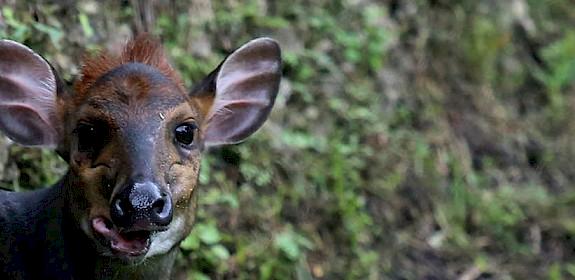World experts: all pangolin species at risk from illegal trade
Singapore, 15th July 2013—A recent gathering of global pangolin experts has concluded the scaly mammals are more threatened now than ever, with all eight species threatened by illegal trade for their meat and medicinal use of their scales.

Currently international trade in the four species of Asian pangolin is not permitted under CITES (the Convention on International Trade in Endangered Species of Wild Fauna and Flora), while international trade in the four African species is only allowed provided the correct CITES permits accompany shipments—however, this is rarely the case.
The landmark meeting on the conservation of pangolins was organized by the International Union for Conservation of Nature—Species Survival Commission (IUCN-SSC) Pangolin Specialist Group and Wildlife Reserves Singapore.
The conference noted that at least 218,100 pangolins had been seized between 2000 and 2012—a figure likely to represent only a fraction of those being illegally traded. Ninety per cent of these were seized from mainland China, Hong Kong, and four South-East Asian nations—Indonesia, Malaysia, Viet Nam and Thailand. Live animals and meat represented some 60% of all pangolins seizures, while the rest included scales and whole carcasses.
It saw the gathering of Asian and African pangolin experts, who kick-started the process of re-assessing the status of the world’s eight pangolins species for the IUCN Red List of Threatened Species. The Red List is recognized as the most comprehensive and globally accepted evaluation of the conservation status of plant and animal species.
The first pangolin assessment was carried out in 2008 when only two of the eight pangolin species—the Sunda Pangolin Manis javanica and the Chinese Pangolin M. pentadactyla—were listed as Endangered. The latest information presented at the Conference suggests that populations of all eight pangolin species are in serious decline and an update of the Red List will reflect this.
Research also indicates that the main threats to pangolins have escalated over the years, with illegal trade contributing more significantly to the problem than habitat loss, in part driven by the rising prices paid for pangolins on the black market.
During the meeting, TRAFFIC highlighted the scale of the pangolin trafficking problem in China and Malaysia, the former a significant consumer country, the latter a source and transit point. TRAFFIC raised the need for stiffer penalties and more effective prosecution efforts to secure convictions.
“Enforcement efforts should not end at seizures—they are only the first of several steps needed to dismantle wildlife smuggling rings,” said Dr Chris R. Shepherd, Acting Director of TRAFFIC in South-East Asia.
“Agencies must be proactive, weeding out the ringleaders behind smuggling operations and putting them out of business.
“Investigators and prosecutors must also prepare thoroughly so that when cases are presented in court they are strong enough for the judge to make a ruling fitting the crime.”
Cases highlighted by TRAFFIC during the meeting included the sentencing of a Malaysian national to life imprisonment for trafficking 2,090 frozen pangolins and 1,800 kg of scales from Malaysia to Guangdong, China, in 2010. He was arrested in China and sentenced along with four others convicted in the same case who received between five and 10 years each in prison.
Comparatively, the highest sentence meted out thus far in Malaysia was in June 2013, against a group of six men who attempted to smuggle 150 pangolins across the country’s land border with Thailand. Their fines totalled RM330,000 (approximately USD103,000), and each man was sentenced to a year in jail. In a separate case in 2012 two businessmen were jailed just one day and fined RM100,000 (USD31,342) each for the illegal possession of 135 pangolins.
Experts agreed that a suite of actions was crucial to curbing this trade. The Conference proposed ramping up law enforcement efforts, improving habitat protection, reducing consumer demand, and improving community stewardship in and around pangolin habitats as key components in any plan to tackle the poaching and trade of pangolins.




